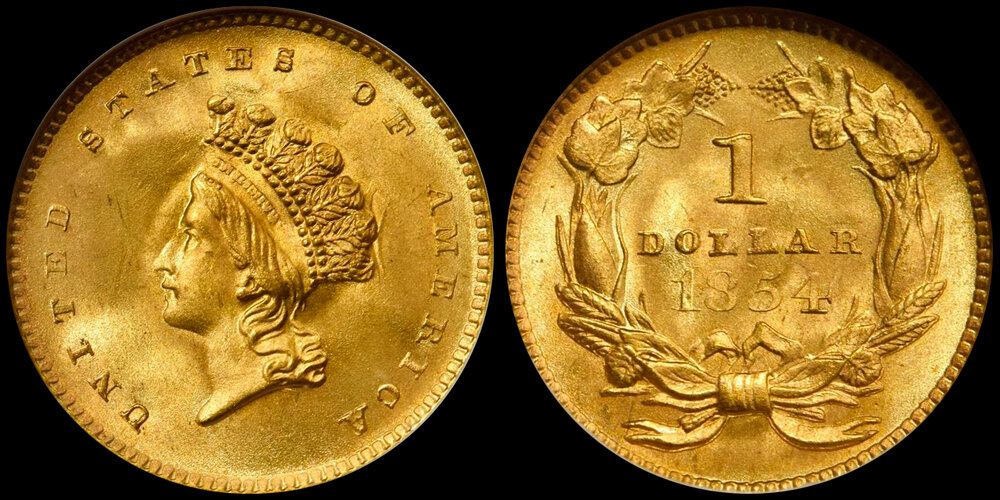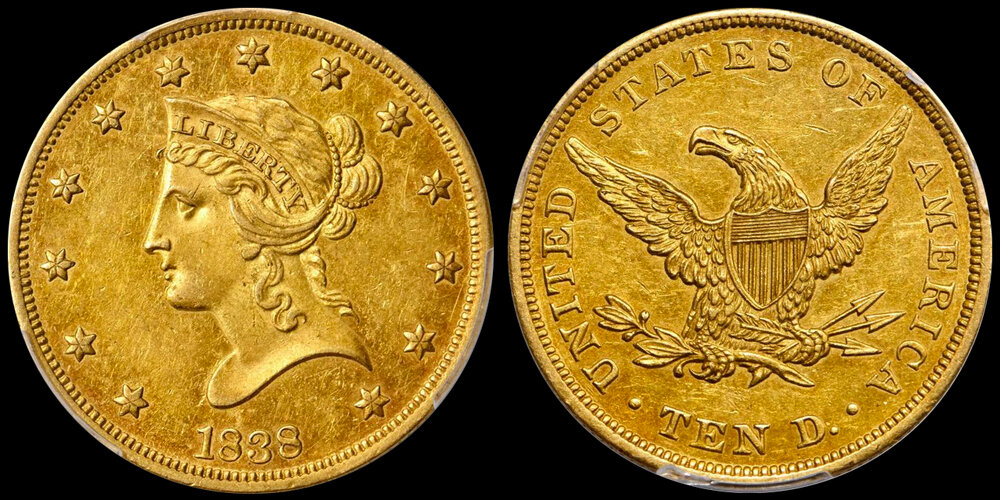The Stack's Bowers 2021 Post-ANA Auction: Some Gold Highlights with Analysis
/The Stack’s Bowers (and Heritage) ANA auctions were historically significant in this most unusual year as they were held the week after the in-person convention.
From a purely selfish point of view, I was happy about this. First, I wouldn’t have to put in any 16+ hour days at ANA, which is par for the course when I work at the show until 5pm and am then bidding until 10pm. Second, it meant that I would be able to offer my coins before the auctions would offer their coins and I much appreciated the head start.
Given the current state of the market, I’m sure that Stack’s Bowers was happy to give me the head start. There is a lot of demand right now for really good coins and between what I had to sell and what Stack’s Bowers had available, the supply clearly isn’t enough to keep up with the demand. I expected the sale to be strong and, for the most part, it didn’t disappoint.
Let’s take a look at a few of the more interesting coins in the sale.
LOT 4157, 1854 GOLD $1.00 NGC MS68
This was the Eliasberg coin and while it was drop-dead gorgeous (as one would expect a 68 to be), it seemed just a touch less nice than the two PCGS/CAC MS67+ examples which sold within the last two years (The Simpson coin in February 2021 at $156,000, and the Pogue coin for $120,000 in March 2020). This exact coin had last sold in Bowers and Merena’s 7/2002 auction fort $126,000, and the other NGC MS68 1854 Type Two gold dollar (this is a pop 2/0 coin) sold for $161,000 in January 2009.
Lot 4157, 1854 $1.00 NGC MS68
The coin brought $156,000 which was a fair but not overly strong price. Had the coin been PCGS/CAC I would have expected it to bring over $200,000. This was a nice purchase for the collector who isn’t necessarily playing the Set Registry game but who wants to own an uber-grade Type Two gold dollar.
LOT 4165, 1796 WITH STARS $2.50 PCGS MS62
This coin was totally fresh to the market. I had mixed reactions to it. I thought it was accurately graded and it had great eye appeal but I thought it had an awful lot of rub on the cheek of Liberty. This issue is actually rarer than the better-known 1796 No Stars, and it is a major rarity in Uncirculated with three or four known. The best is clearly the ex: Simpson coin which sold in January 2021 for $1,380,000. I sold an NGC MS63 (now graded MS62+ by PCGS/CAC) for $324,000 in 2017, and the PCGS MS62 Pogue coin brought $440,625 in May 2015.
Lot 4165, 1796 $2.50 With Stars, PCGS MS62
I was expecting this coin to bring around $325,000-350,000, and it brought $456,000 which I regard as an extremely strong price. I’m guessing that if the coin had been approved at CAC, it would have brought $550,000-650,000.
LOT 4166 1797 $2.50, PCGS AU58
I love this date. It’s an overlooked rarity despite a tiny mintage of 427 and it has a very distinctive appearance as every known example shows a massive obverse die crack on the right side of the coin which tells you how shoddy the mint’s operations were in 1797 in terms of production. Around three dozen exist in total, with perhaps two or three in AU58 and another two or three in Uncirculated.
Lot 4166 1797 $2.50, PCGS AU58
I wasn’t crazy about the coin in the Stack’s Bowers sale. It had pretty color but the fields were awfully busy for a 58. The most recent APR for a PCGS AU58 was the Pogue coin which realized $152,700 but which was a real 58, in my opinion. The coin brought $168,000 was I feel is very strong given its quality, but which may seem “reasonable” or even sort of “cheap” to a novice collector.
LOT 4210 1870-CC $5.00, PCGS AU58
As soon as I saw this coin featured in a Stack’s Bowers consignment ad sent to me via email months ago, I forwarded this to a good friend and wrote: “This 1870-CC $5 is going to bring a fortune.”
Lot 4210 1870-CC $5.00, PCGS AU58
Carson City gold is absolutely on fire right now and everyone needs an 1870-CC half eagle (or eagle or double eagle…) for their set. This was the first comparatively high grade example to come on the market for some time, and I thought the coin was pretty decent for the grade.
The last auction appearance for this date in AU58 was all the way back in 2006 and an NGC MS61 (which I disliked) had sold for $102,000 in January 2020. So, nothing under $200,000 would have surprised me for this coin. It sold for $150,000 which is an all-time auction record for the date, and likely the highest price ever paid for any circulated CC half eagle.
LOT 4225 1799 $10, PCGS MS64 WITH CAC APPROVAL
Think a CAC sticker doesn’t add value? This “common date in an uncommon grade” represented the first CAC approved 1799 $10 to ever sell at auction. I liked this coin but given the fact that CAC lists nine approved in MS64 with five finer, I was curious to see just how much of a premium factor the sticker would carry. FYI, two non-CAC PCGS MS64+ 1799 eagles sold for $126,000 each in 2020, and a nice non-CAC PCGS MS65 brought $188,000 in another 2020 auction.
Lot 4225, 1799 $10.00 PCGS MS64 CAC
The coin brought $204,000 which means that the CAC approval meant an estimated 60% premium (based on a non-CAC PCGS MS64 being worth around $130,000 in today’s market).
LOT 4229, 1838 $10, PCGS AU58+
I loved this coin from a quality standpoint. It was mostly Prooflike with nice original color and just a hint of rub. It was truly a Gem Slider and you’d be lucky to find an 1838 eagle in a 62 holder with this much eye appeal.
Lot 4229, 1838 $10.00 PCGS AU58+
This first-year-of-issue is really scarce in the higher AU grades and very rare with Uncirculated with around five or six known; none of which could be bought today for less than $100,000.
The most recent APR for an 1838 $10 in PCGS AU58 was $40,800 for a pretty meh example sold in 2020. In 2016, a nice CAC approved PCGS AU58 sold for $64,625.
This coin sold for $52,800 which I regard as a fair price for the coin. If this coin ever stickers (which I think it should) it could easily eclipse the 2016 auction record mentioned above.
LOT 4235, 1884-CC $10, PCGS MS62+
This fresh-outta-Europe coin was probably my favorite lot in the sale. It is one of just two or three really “new” 1884-CC eagles I’ve seen. There’s one finer than this (a PCGS MS63 from the Bass collection) while the previous second-finest is the PCGS MS62 in the Tyrant Collection. Given all this and the fact that great CC gold coins are, as I said above, sizzling right now, I expected this coin to bring around $80,000-90,000. It set a record for the date at $132,000.
Lot 4235, 1884-CC $10.00 PCGS MS62+
Was I surprised? A little but I certainly wasn’t shocked. This isn’t as sexy a date as one of the low mintage CC issues from the 1870s, but given its rarity, its terrific eye appeal, and approval by CAC, I understand the strong price.
LOT 4257, 1888 $20 PCGS MS65 WITH CAC APPROVAL
Like so many Type Three double eagles, the 1888 fits the following rarity profile: common in grades through MS62+, a bit scarce in MS63, rare in properly graded MS64, and exceedingly rare in MS65. After three+ decades of grading, this 1888 remains the only example of this date to ever slab MS65 at PCGS. And not only that, this coin wasn’t a pretend MS65 which had been doctored after being in a 64 holder. It was a stone Gem and an exceptionally nice piece.
Lot 4257, 1888 $20.00 PCGS MS65 CAC
Only one PCGS MS64 had sold at auction in the past decade+ and it realized $14,400 in late 2020. In 2004, an NGC MS65 sold for $25,300. Based on all of these numbers, I expected this coin to bring $45,000-55,000. Instead it smashed all expectations and brought an incredible $92,000.
I’m going to assume that this went to a prominent Utah collector who owns the best set of $20 Libs ever assembled… but I wonder who his underbidder(s) were.
All in all, the August 2021 Stack’s Bowers Rarity Night sale was strong to very strong. If you are hunting for bargains in today’s market, auctions appear to be the least likely place to find them.

















